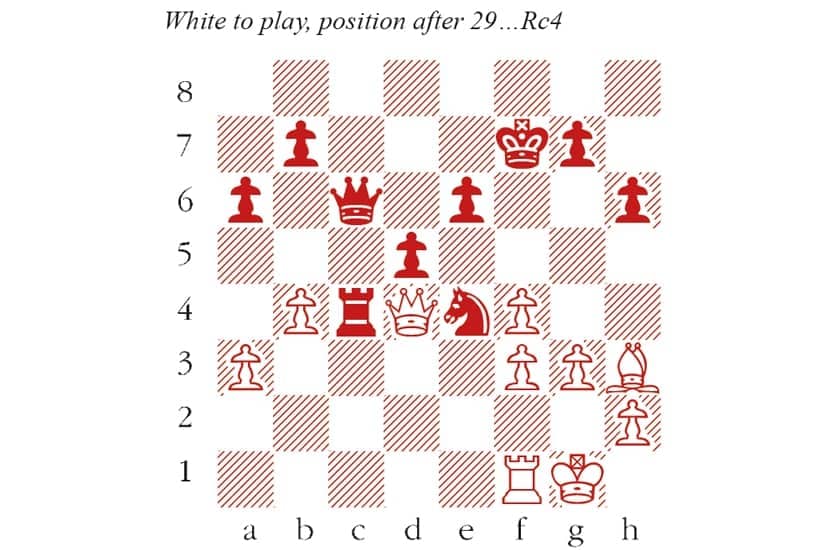Richard Rapport took first place at the Fide Grand Prix in Belgrade last weekend. The Hungarian grandmaster is now almost assured of a place in the Candidates tournament in Madrid later this year, which will determine a challenger for the World Championship. Only a very unlikely outcome at the final Grand Prix event (which begins in Berlin next week) would see him knocked out of the cycle.
Rapport is popular with fans for his rich imagination and penchant for offbeat openings. In the past, that sometimes made for erratic results, but a newfound consistency has propelled him into the world’s top ten. The diagram position shows the critical moment from the final match. Rapport could repeat moves with 30 Qe3, leading to a draw by repetition in light of the previous moves. Instead he used up nearly all his time and chose the ambitious 30 Qe5. Though it allowed Andreikin’s knight into d2, Rapport saw that need not interrupt his attack.
Richard Rapport-Dmitry Andreikin
Fide Grand Prix, Belgrade, March 2022
1 d4 d5 2 c4 e6 3 Nc3 a6 4 cxd5 exd5 5 a3 h6 6 Bf4 Nf6 7 e3 c5 8 Be5 Be6 9 Nge2 Nc6 10 Nf4 cxd4 11 Bxd4 Nxd4 12 Qxd4 Bd6 13 g3 Rc8 14 Rd1 Qa5 15 Rc1 O-O 16 Nxe6 fxe6 17 Bh3 Kf7 18 O-O Rc4 19 Qd3 Be5 20 Ne2 Rfc8 21 Rxc4 Rxc4 22 b4 Qa4 23 Nf4 Bxf4 24 exf4 Qc6 25 Qe3 Ne4 26 f3 Rc3 27 Qd4 Rc4 28 Qe3 Rc3 29 Qd4 Rc4 (see diagram) 30 Qe5 Nd2 Placing the queen on e3 was safer. Now if 31 Rf2 Rc1+ 32 Kg2 Nc4! Black gains a decisive advantage, e.g. 33 Qd4 Rd1! 34 Qa7 d4. 31 f5 Nxf1 This move is good enough for a draw, but requires an extraordinary follow-up. Another path to a draw was 31…Qb6+ 32 Kh1 Nxf1 33 fxe6+ but that also demands extreme precision from Black. For example, 33…Ke8? 34 Qh5+ Kd8 35 Qxd5+ wins. In fact, the only move which draws is 33…Kg8! when the imminent counterattack with Nf1xg3+ means that White has no time to advance the e-pawn. Instead White should bail out for a draw. One pretty line goes 34 Qb8+ Kh7 35 Bf5+ g6 36 Bxg6+ Kxg6 37 Qg8+ Kf6 38 Qf7+ Ke5 39 Qg7+! and here Black must acquiesce to the draw, since 39…Kxe6 40 Qxh6+ wins with a skewer, or 39…Kd6 40 Qd7+ forces the king back to e5. 32 fxe6+ Where should Black put the king? Unlike in the line above, 32…Kg8 is well met by 33 e7!, and then 33…Kf7 34 e8=Q+ Qxe8 35 Qxd5+ wins the rook, or 33…Qb6+ 34 Kxf1! is similar to the game. Andreikin’s next move looks like the only plausible alternative, but it turns out to be the decisive mistake. Ke8 In fact, the strongest move was extremely hard to foresee: 32…Ke7! allows White to capture with check, but after 33 Qxg7+ Kd6 there are several tries which all fall short. For example, 34 Qf8+ Kc7 35 e7 Qb6+ 36 Kxf1 Rc1+ 37 Ke2 Re1+ 38 Kxe1 Qe3+ and Black draws by perpetual check. 33 Qxg7 Qb6+ The advanced pawn affords White all manner of tactics. For example, 33…Qd6 34 Qf7+ Kd7 35 e7+! Qxe7 36 Qxd5+ wins. Or 33…Qc7 34 Qg6+ Ke7 35 Bxf1 Rc1 36 Qf7+ Kd6 37 e7! Qxe7 38 Qf4+ forks the rook again. 34 Kxf1 Rc1+ 35 Ke2 Re1+ The perpetual check is a mirage, but there was no better try. 36 Kxe1 Qe3+ 37 Kd1 Qd3+ 38 Kc1 Qe3+ 39 Kb1 Qd3+ 40 Kc1 Qe3+ 41 Kb2 Qd2+ 42 Ka1 Qc1+ 43 Ka2 Qc4+ 44 Kb2 Qe2+ 45 Ka1 White meets a check on e1 or d1 with Ka1-a2, when a subsequent check can be blocked by Qg7-b2. Andreikin falls on his sword: Qf1+ 46 Bxf1 Black resigns






Comments